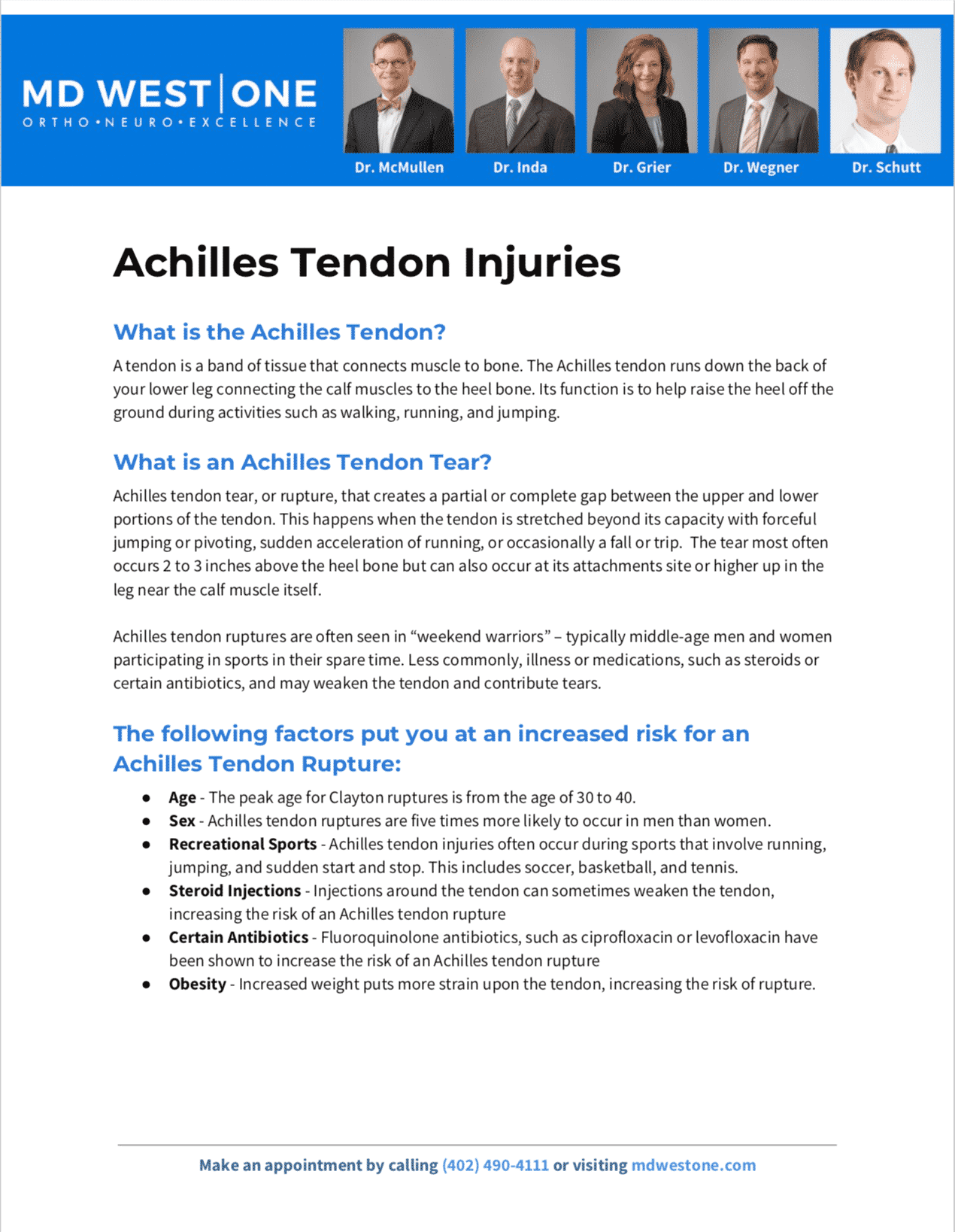Are you suffering from potential Claw Toe?
The Omaha Foot & Ankle Specialists at MD West ONE are able to properly diagnose and treat claw toe through both surgical and non-surgical treatments. If you have the following symptoms, you may want to make an appointment with one of our Board Certified Specialists.
- Corns
- Calluses
- Blisters
- Pain
- Swelling
- Ulcers (rare)
Meet MD West ONE's foot and ankle specialists and learn more about how they treat claw toe.
Claw Toe Causes, Treatments & Surgery
What is claw toe?
Claw toes, as the name implies, are toes bent into an abnormal claw-like shape. The condition usually happens to the four smaller toes of your foot and it is the middle and end joints (the joints furthest away from your ankle) that buckle.
Claw toes are often associated with a high arched (cavus) foot type, muscle imbalances or occasionally a neurological condition. Ulcers may develop in people with diabetes because of decreased foot sensitivity.
If you do not get treatment for your claw toes, they may become permanently stiff.
The following factors put you at an increased risk for claw toe:
-
People with high arches.
-
People who tend to rotate their feet inward while walking.
-
Hereditary
Ways to Decrease Your Risk of Developing Claw Toe Problems:
- Exercise your toes: Stretch your toes out and pick up small objects with your toes.
- Wear sensible shoes: The best shoes if you’re prone to claw toes have good arch support, short heels and an extra wide toebox.
- Pumice stone: Use a pumice stone to file down your corns and calluses.
DIAGNOSIS
Most of the time an imbalance of foot muscles typically causes claw toes. Specifically, your toe muscles contract too far, tighten the tendons and bend the joints. Foot muscles become unbalanced due to the following factors:
- Genes
- Ill-fitting shoes
- Nerve damage caused by diabetes
- Rheumatoid arthritis or osteoarthritis
- Nerve damage cause by alcoholism
- Charcot-Marie-Tooth Disease
- Spinal cord tumors
- Polio and cerebral palsy
- Stroke - the stroke-side foot is affected
- Trauma
NON-SURGICAL TREATMENT OPTIONS
- Wearing shoes that have roomy toe boxes, low heels and good arch support.
- Wearing shoes with an increased width and depth, with soft soles and minimal seams in the toebox.
- Wearing pads, arch supports or other shoe inserts to cushion the toe.
- Strengthening and stretching toe muscles through exercises.
- A splint or tape to hold your toes where they are supposed to be.
- Avoid high heels.
- Avoid tight shoes.
SURGICAL TREATMENT OPTIONS
The severity of your claw toes determines what type of surgery you will have. Your healthcare provider will categorize your claw toe as early or late stage, either flexible or rigid. Surgical treatments for claw toes include:
- Tendon lengthening and rerouting.
- Shortening the bones of the phalanx.
- Temporarily inserting a steel pin to hold the toe in the correct position until healing occurs.
- Toe fusion.
POST-OPERATIVE RECOVERY
Your claw toe surgery will be outpatient, meaning that you will not have to spend a night in the hospital. Recovery is roughly about four to six weeks.
Frequently Asked Questions?
How are claw toes diagnosed?
Your healthcare provider will perform a physical examination of your toes, likely touching them to see how they move.
You may be tested for neurological problems. Some neurological disorders can weaken the muscles of your foot, which creates imbalances that bend your toes.
Your primary healthcare provider may refer you to a podiatrist and/or a foot and ankle orthopedic surgeon.
What questions might my healthcare provider ask to diagnose claw toes?
Your healthcare provider may ask the following questions during your appointment:
- When did you start to notice your toes bending?
- Do you have any corns?
- Do you have any calluses?
- Have you tried any at-home treatments?
- Do members of your family have claw toes?
- What is the cause of your family members’ claw toes?
AMERICAN ORTHOPAEDIC FOOT & ANKLE SOCIETY
All of the foot and ankle surgeons in the practice are recognized members of the American Orthopaedic Foot & Ankle Society. It is the oldest and most prestigious medical society dedicated to the foot and ankle. The mission of the society is to advance science and practice of foot and ankle surgery through education, research, and advocacy on behalf of patients and practitioners. These physicians dedicate their time and energy to improving the patient experience and their knowledge in their field. For more information visit http://www.aofas.org.
MD West ONE Foot & Ankle Specialists:
The Foot & Ankle Specialists are all Board Certified and Fellowship-Trained, meaning they’ve focused their education, training and research on orthopaedic surgery of the foot and ankle.






